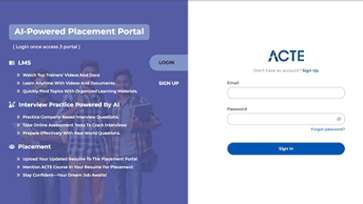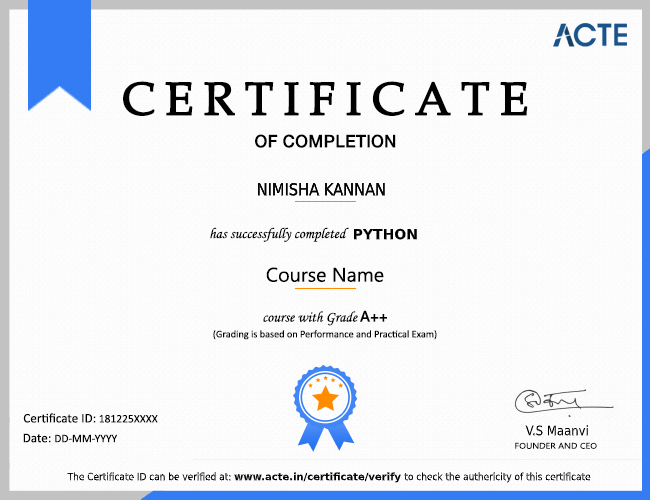ACTE's IBM WebSphere Commerce Server Online Course will help you develop the skills you need to perform the day-to-day operations and maintenance of IBM WebSphere Commerce. Provides in-depth knowledge of installing, configuring, administering, deploying, troubleshooting, security, performance tuning, and more, through hands-on labs. Working with real examples. At the end of the IBM WebSphere Commerce Server Online Training, you will learn how to administer IBM WebSphere Commercial Server, delivering real-time projects under the guidance of a certified IBM WebSphere expert.
Additional Info
About IBM WebSphere Commerce Server Training:
In the WebSphere Commerce Server Course curriculum, students learn the skills necessary to continuously operate and maintain IBM WebSphere Commerce V7. The IBM WebSphere Commerce Server Online Course begins by explaining how to install, configure, and manage WebSphere Business, and continues with topics such as deployment, configuration, security, ongoing maintenance, and performance tuning for WebSphere repositories. Students will also learn how to administer IBM WebSphere eCommerce V7 and the new and unique features of the associated feature packs. These include installing mobile and social business features, optimizing for search engines, working with advanced features, and managing payment infrastructure.
During the course, hands-on labs guide students through the key tasks associated with managing an IBM WebSphere Commerce installation. This training covers skills such as installing and configuring WebSphere Business, installing and configuring debug packages and features, running your own bootstrap, configuring infrastructure news, and publishing business features to mobile and social devices.
Responsibilities of IBM WebSphere Commerce Server:
- Technical solutions related to IBM WebSphere (WCS) for various projects and operational needs.
- Install a new server / rebuild an existing server and set up hardware, peripherals, services, configurations, directories, storage, and more. Comply with design/performance standards and requirements.
- Installation, configuration, and maintenance of IBM business systems.
- Introduce and maintain system standards.
- Research and recommend innovative methods and, if possible, automated approaches to system administration tasks. Identify approaches that make the most of our resources and provide economies of scale.
- Perform daily system monitoring by checking the integrity and availability of all critical hardware, server resources, systems, and processes, reviewing system and application logs, and checking scheduled tasks such as security backup jobs.
- Perform daily backups to ensure that all essential system data and file systems are properly backed up to the correct media, created recovery tapes or discs, and properly backed up the vehicle.
- Perform regular archiving and cleaning of files as needed.
- Provides level III / other assistance needed in many counties. Identify and solve problems.
- Repair and recovery of hardware or software failures. Coordinate and communicate with the affected areas.
- Apply patches and updates to the operating system regularly, and update administrative tools and utilities. Configure / add new services as needed.
- Support for other operations, configurations or processes.
- Provides periodic performance reports to support capacity planning.
- Perform ongoing performance tuning, hardware upgrades, and resource optimizations as needed.Configure the CPU, memory, and disk partitions as needed.
- Maintenance of monitoring equipment and data center environments.
Framework of IBM WebSphere Commerce Server
The server runtime in IBM WebSphere Commerce Server defines the infrastructure for handling user and system requests and implements the necessary business logic. The platform is built using the MVC design pattern and provides a framework for storing business logic and ensuring consistency. Transaction management and session management are examples of tasks.
IBM WebSphere Commerce Server and WebSphere support a variety of security mechanisms for securing access to data and other server assets. The access control infrastructure in IBM WebSphere Commerce Server does not allow users to execute certain business logic. business logic and flexibility to restrict access to data that users can view and modify. With access control, you can group teams by access groups, assign different client teams to different owners, and specify all the site owner and admin access rights ... the global admin. Using WebSphere global security, you can control access to web resources such as servlet files, JavaServer Pages (JSP) methods, and Enterprise JavaBeans (EJB) methods to improve security.
Command Framework, an architectural component of the IBM WebSphere Commerce Server server runtime, provides the ability to run commands that represent various business processes in the system. The command structure defines Java interfaces and abstract implementations that business logic extends and implements. a set of base classes that can be expanded into groups to simplify implementation.
Tips and tools for IBM WebSphere Commerce Server
- Recommended React Store instead of old Aurora
- Store Use Elasticsearch instead of SOLR Comes with NLP search Don't miss out on next-gen e-commerce
- Elasticsearch is an open-source engine that can be configured separately on any Windows machine. HCL Commerce Use docker image to customize your workspace
- Try all NIFI links, will test well fast
- V9.1.3 is more distributed in nature than V9.
- Xc Server, Legacy Server, and Search Server are all examples of servers. There are too many servers. However, it is critical to creating a more distributed architecture. This could be the path to a clean microservice architecture. Yes, HCL commerce needs more and more changes to become a full
- Publish Emerald microarchitecture for B2C customers. Don't forget to try out the exciting default NLP feature offered by Emerald + Elasticsearch. (Example: I am looking for a blue sofa) Yes, you will get a blue sofa.
- As of December 1, 2020, the Emerald Store has not yet received all the features of a full-fledged e-commerce store.
- By default, Emerald disables the order history page. You must enable it according to the instructions.
- Publishing Sapphire Store for B2B customers
- 9.1.3 comes with Composer as a CMS tool. But for Emerald, it won't work. You can just use the Aurora store. As far as I know, HCL may release a sophisticated new enterprise-grade content management system.
IBM WebSphere Commerce Server Developer Background and Scope
- Developer and platform responsibilities include designing and developing application components in a flexible environment, both web components and internal components.
- Applicant is expected to participate in the collection of requirements, documentation, and development of WCS functionality and related enhancements to the application. This includes support for application integration testing, integration development, data transformation, and transition operations.
- Design, develop, and deploy multi-tier business applications to support business requirements in flexible environments, both web components and server components.
- Build and review projects and identify reuse, performance issues, and best practices for commerce, services, and Java.
- Supports the full lifecycle of store pages, data warehouse, business logic store, WebSphere Commerce tool customization, and back-end system integration.
- Implement solutions for public websites based on business requirements.
- Perform unit testing before moving code / configuration into QA. Investigate defects and troubleshoot root causes in applications.
- Identify key obstacles / major problems and apply problem-solving skills to creatively deal with difficult situations.
Integration module of IBM WebSphere Commerce Server
The content integration with the corresponding WebSphere Commerce instance uses the built-in WebSphere Commerce data load functionality, which is based on bulk data file loading.
- Introduction to Advanced Portfolio Management
- IBM WebSphere Commerce provides a powerful customer engagement platform for omnichannel commerce. It can be used by companies of all sizes, from small to large, and across a wide variety of industries.
- Installing and configuring Advanced Catalog Management
- This installation section provides instructions for installing Advanced Catalog Management content on the InfoSphere Master Data Management Collaboration Server Collaboration Server Collaborative Edition and WebSphere Commerce platforms, including the WebSphere Commerce platform. Includes the configuration of the provided default objects (for example, default navigation, default view, and default workflow).
- Advanced Directory Management Migrations
- The following co-versions of MDM support Advanced Directory Management (ACM) migrations.
- Configuring property stores, categories, and dictionaries
- The following sections provide detailed information on how to configure and manage property stores, categories, and dictionaries.
- Allows multiple languages
- You can create attributes for each item in multiple languages in IBM InfoSphere Master Data Management Server Collaboration Edition and export these properties to WebSphere Commercial Server.
- Managing catalog data
- This content manages the following three types of catalog objects for WebSphere Commerce.
- Publishing catalog data
- In this content, you can use a common integration platform that you can extend to use export of common data.
- Setting up your development environment
- When setting up your development environment, make sure you are familiar with the following.
- Advanced Directory Management Debugging
- After the projects are set up in the workspace, the extended directory management code can be debugged using a remote debugger connected to the InfoSphere Master Data Management Application Server and Collaboration Scheduler.
- Advanced catalog management extensions
- Advanced catalog management solutions provide the infrastructure for publishing data from the InfoSphere Master Data Management Collaboration Server Collaborative Edition to WebSphere Commerce Server.
Certification of IBM WebSphere Commerce Server:
Certificates play an important role in getting your dream job. This shows that you have acquired all the skills you need to solve important real problems with or without the help of your subordinates. Organizations love to hire certified candidates and offer huge pay packages.
At ACTE, training courses help students to obtain appropriate certifications. In addition, we also offer a Certificate of Completion for every course we offer. This certification shows that you are qualified enough to handle real-time work and also sets you apart from the crowd.ACTE certification is recognized by all major multinational companies and makes it easy to get a job.































